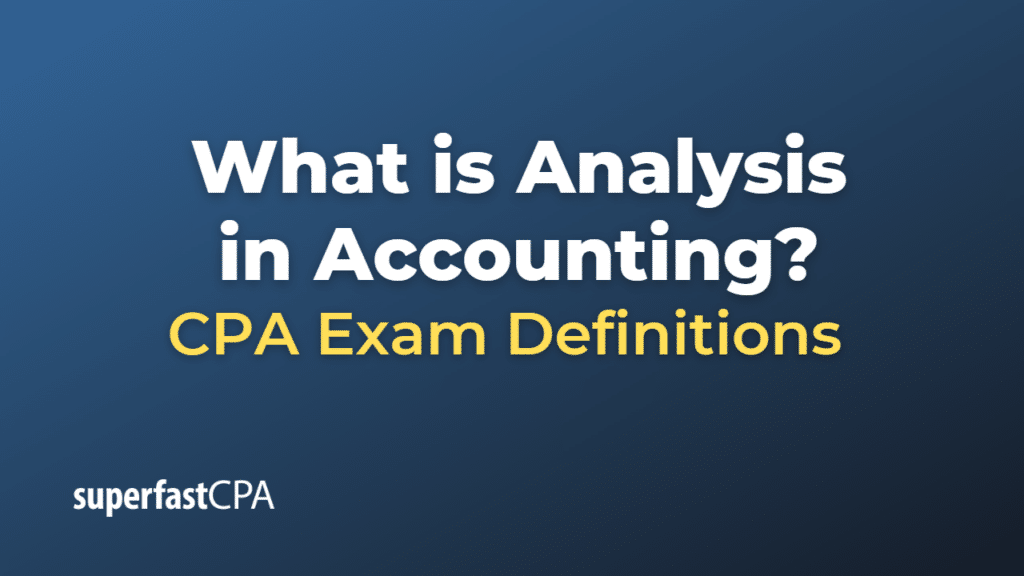Analysis
In accounting, analysis refers to the process of examining, interpreting, and understanding financial information presented in financial statements, reports, and other accounting records. It involves breaking down and evaluating financial data to support decision-making, identify trends, assess financial health, and improve the overall understanding of a company’s financial performance.
Accounting analysis can include various techniques and methods, such as:
- Ratio analysis: This involves calculating financial ratios using the data from financial statements to assess a company’s liquidity, profitability, solvency, and operational efficiency. Examples of financial ratios include current ratio, debt-to-equity ratio, and return on equity.
- Trend analysis: This involves analyzing changes in financial data over time to identify patterns, trends, and potential areas of concern or improvement. For instance, revenue growth rates or changes in gross profit margins can be examined to determine the company’s performance over several periods.
- Variance analysis: This method involves comparing actual financial results to budgeted or forecasted numbers to identify discrepancies, understand the reasons for the differences, and take corrective actions if necessary.
- Horizontal and vertical analysis: Horizontal analysis involves comparing financial data over multiple periods, while vertical analysis focuses on analyzing the relationships between items within a single period. These methods help assess a company’s financial performance over time and identify changes in the composition of financial statements.
- Cash flow analysis: This involves examining a company’s cash inflows and outflows to assess its liquidity, solvency, and ability to generate cash from operations, investing, and financing activities.
Accounting analysis helps stakeholders, such as management, investors, creditors, and regulators, make informed decisions about a company’s financial position, performance, and future prospects.
Example of an Analysis
Let’s use a simplified example of ratio analysis to assess the financial performance of a hypothetical company, ABC Corporation.
Financial data for ABC Corporation (in USD):
- Revenue: $500,000
- Net Income: $50,000
- Total Assets: $300,000
- Total Liabilities: $150,000
- Total Equity: $150,000
- Current Assets: $200,000
- Current Liabilities: $100,000
We can use this financial data to calculate some key financial ratios:
- \(\text{Current Ratio} = \frac{\text{Current Assets}}{\text{Current Liabilities}} \)
\(\text{Current Ratio} = \frac{200,000}{100,000} = 2.0 \)
A current ratio of 2.0 indicates that ABC Corporation has $2 in current assets for every $1 in current liabilities, suggesting that the company has adequate liquidity to meet its short-term obligations.
- \(\text{Debt-to-Equity Ratio} = \frac{\text{Total Liabilitiess}}{\text{Total Equity}} \)
\(\text{Debt-to-Equity Ratio} = \frac{150,000}{150,000} = 1.0 \)
A debt-to-equity ratio of 1.0 suggests that ABC Corporation has an equal proportion of debt and equity financing its assets. This may be considered reasonable, depending on the industry and company size.
- \(\text{Return on Equity (ROE)} = \frac{\text{Net Income}}{\text{Total Equity}} \)
\(\text{ROE} = \frac{50,000}{150,000} = 0.33 \text{ or 33%} \)
A return on equity of 33% indicates that ABC Corporation is generating $0.33 in net income for every $1 of equity invested in the company. This ratio can be compared to industry benchmarks or the company’s historical performance to assess its relative profitability.
By analyzing these financial ratios, we can gain insights into ABC Corporation’s liquidity, capital structure, and profitability. This analysis can help stakeholders make informed decisions about the company’s financial health and performance. Keep in mind that a more comprehensive analysis would involve additional ratios and methods, as well as considering industry-specific factors and the broader economic environment.













